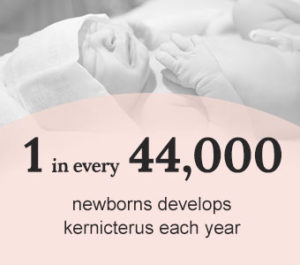What is kernicterus?
Kernicterus is a neurological disorder that occurs when abnormally high levels of bilirubin in the blood are deposited into a baby’s brain tissue, especially in the basal ganglia (the part of the brain that’s responsible for motor control).
 Kernicterus is usually associated with severe, untreated cases of jaundice in newborns. The medical term for kernicterus is bilirubin encephalopathy (BE).
Kernicterus is usually associated with severe, untreated cases of jaundice in newborns. The medical term for kernicterus is bilirubin encephalopathy (BE).
Even though it can be treated, kernicterus can cause permanent brain damage in newborns. The extent of the brain damage depends on when kernicterus is diagnosed and treated.
Unfortunately, kernicterus can result in serious complications such as hearing loss and cerebral palsy if significant brain damage occurs before treatment.
Did your child develop cerebral palsy from kernicterus brain damage? Chat with one of our dedicated nurses to learn whether you may be able to access financial assistance.
What causes kernicterus?
Kernicterus is the result of severe infant jaundice that is left untreated over a period of time. Jaundice is caused by too much bilirubin in the blood, also known as hyperbilirubinemia.
Bilirubin is a yellow-orange pigment that’s created when the liver breaks down red blood cells. It’s usually removed from the body as waste through a baby’s stool.
Because a baby’s liver isn’t as fully developed as an adult’s liver, it can’t remove bilirubin as effectively.
This helps explain why more than half of babies get jaundice after birth, according to the Centers for Disease Control and Prevention (CDC). However, if diagnosed and treated early, jaundice is typically harmless and goes away within 1-2 weeks.
Kernicterus occurs when bilirubin levels become so high that they spread to the brain and damage the central nervous system.
In developed countries, only 1 in every 44,000 newborns develops kernicterus each year. This is because newborn jaundice is usually treated before it becomes dangerous.
Kernicterus symptoms


The whites of the eyes may also look yellow depending on how much bilirubin has built up.
If jaundice isn’t treated promptly and progresses into kernicterus, the baby may have more severe symptoms.
Initial signs of kernicterus include:
- Decreased alertness
- Extreme sleepiness
- Low muscle tone (hypotonia)
- Poor feeding
- Severe yellowing of the skin and whites of the eyes
In the middle stages of kernicterus, the baby may develop a high-pitched cry, irritability, and an arched back and heels (like a bow).
Babies with late-stage kernicterus may experience:
- Fever
- No appetite
- Seizures (epilepsy)
- Stiff, limp, or floppy muscles
- Strange eye movements
- Stupor or coma
Kernicterus can become life-threatening or cause serious brain damage if treatment is delayed. If your baby is showing any signs of late-stage kernicterus, you should get emergency medical help right away.
Kernicterus diagnosis
The CDC recommends checking babies for jaundice every 8-12 hours in the first 48 hours after birth. A doctor or nurse should continue to check bilirubin levels during follow-up visits after the baby is brought home, particularly within 2-3 days of leaving the hospital.
This is usually done by placing a light meter on the baby’s head. The light meter will determine how much bilirubin is in the skin (transcutaneous bilirubin (TcB) level).
If the baby’s TcB level is high, a blood sample can show the amount of bilirubin more precisely. The doctor may also perform a physical exam to look for signs of kernicterus and determine if brain damage has started.
Newborns with bilirubin higher than 25 milligrams should be treated for kernicterus in the hospital and monitored until their levels fall within a normal range.
Early diagnosis and treatment are critical to preventing deafness, cerebral palsy brain damage, and other possible complications of kernicterus.
Did your baby develop kernicterus from untreated jaundice? Our team can review your case for free to see if medical negligence may have played a role.
Kernicterus treatment
Kernicterus is a serious condition that requires immediate medical treatment at a hospital. The specific treatment normally depends on how old the baby is (in hours) and whether they are premature or have other risk factors.
The two main types of kernicterus treatment are light therapy and blood transfusions. The doctor might also recommend that the baby’s milk intake be increased to help them go to the bathroom more frequently and eliminate the excess bilirubin.
Light therapy
Also called phototherapy, this is usually the first line of treatment for newborns with kernicterus. The baby is placed under a special light or on top of a light therapy blanket (sometimes called a bili blanket).
The specific wavelengths of light used during phototherapy help break down bilirubin into a form that the baby’s body can remove more easily.
The hospital will check the baby every few hours until their bilirubin levels begin to fall and then every 6-12 hours until treatment is complete. The entire process usually takes 1-2 days.
Transfusions
Blood or plasma transfusions may be recommended if the baby doesn't respond to phototherapy or has extremely high bilirubin levels.
A transfusion involves replacing the baby’s blood or plasma with donor blood or plasma that is free from bilirubin. Doctors will test bilirubin levels after the procedure to see if additional transfusions are needed.
Kernicterus risk factors
Certain factors increase a baby’s odds of developing jaundice.
The most common risk factors include:
- Blood type: Mothers with an O blood type or Rh negative blood factor are more likely to have babies with higher bilirubin levels.
- Bruising: Babies who are born with bruises from birth trauma, such as an injury from forceps delivery complications, are at greater risk of jaundice. As the bruises heal, the increased amount of red blood cells can contribute to high levels of bilirubin.
- Darker skin: The skin yellowing linked with jaundice is harder to see in babies with a darker skin color. This can increase the chances of it going untreated and potentially advancing into kernicterus.
- Family history of jaundice: A baby with an older brother or sister who had infant jaundice is more likely to have it as well.
- Feeding problems: Babies who aren’t eating enough and eliminating waste frequently through the urine or stool are more likely to get jaundice.
- Mediterranean or East Asian descent: Jaundice is more common in East Asian and Mediterranean families. This is mainly due to an inherited condition known as G6PD deficiency that causes red blood cells to be broken down faster than they’re made.
- Preterm birth: Babies born before 37 weeks (or 8.5 months) of pregnancy may not be able to get rid of bilirubin as quickly as full-term infants since their livers aren’t fully developed.
Doctors and medical staff must be aware of these risks so they can help prevent severe cases of jaundice that may lead to kernicterus.
Kernicterus caused by medical negligence
Because jaundice is so common in newborn babies, there’s no excuse for medical professionals who fail to spot the early signs and provide proper treatment.
If a doctor fails to recognize signs of jaundice or kernicterus, it can be considered medical negligence.
If your baby developed cerebral palsy or other serious complications from kernicterus, contact us today. We can connect you to a birth injury lawyer who may be able to help you pursue compensation for medical bills, treatment, and emotional suffering.
Get a free case review today to discuss your legal options with our team.


